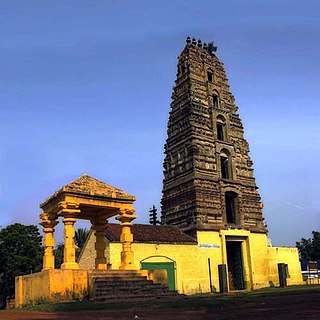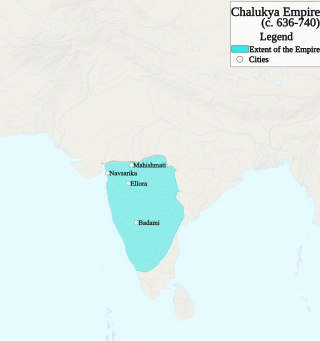
Krishna district is a district in the coastal Andhra Region in Indian state of Andhra Pradesh, with Machilipatnam as its administrative headquarters. It is surrounded on the East by Bay of Bengal, West by Guntur, Bapatla and North by Eluru and NTR districts and South again by Bay of Bengal.

Vontimitta or Ekasilanagaram, is a village in Kadapa district of the Indian state of Andhra Pradesh. It is located in the Vontimitta Mandal of the Kadapa revenue division.

Anantapur district, officially Ananthapuramu district, is one of the eight districts in the Rayalaseema region of the Indian state of Andhra Pradesh. The district headquarters is located in Anantapur city. It is one of the driest places in South India. In the year 2022, as part of re-organisation of districts, Sri Sathya Sai district was carved out.

Kadapa district is one of the twenty six districts in the Indian state of Andhra Pradesh. In the 2022 reorganisation of Andhra Pradesh districts, the district boundary was largely restricted to the Kadapa parliamentary constituency area. It is one of the eight districts in the Rayalaseema region. Kadapa is the administrative headquarters for this district.
Vengi or Venginadu is an Indian region in modern-day Andhra Pradesh spread over the Godavari and Krishna river deltas. The capital city of Vengi is located at Pedavegi near Eluru. Vengi was the most prominent city in Ancient Andhra for nearly seven centuries. Vengi served as the capital for Andhra dynasty like Salankayanas This region was part of Ashoka's Mauryan Empire in the mid-3rd century BCE. After the Mauryan Empire collapsed in 185 BC, the region was dominated by the Satavahanas, who were succeeded in Vengi by the Andhra Ikshvakus. Around 300 CE, the Andhra Ikshvakus were replaced by the Salankayanas. In the late 5th century, the Salankayanas were annexed by the Vishnukundinas.

The Vishnukundina dynasty was an Indian dynasty that ruled over parts of present-day Andhra Pradesh, Telangana, Odisha, and other parts of southern India between the 5th and 7th centuries. They emerged as an independent power during the reign of Madhava Varma, who conquered coastal Andhra from the Salankayanas and established their capital at Denduluru near Eluru. Their rule significantly shaped the history of the Deccan region. However, their reign ended with the conquest of eastern Deccan by the Chalukya king Pulakeshin II, who appointed his brother, Kubja Vishnuvardhana, as viceroy. Vishnuvardhana later declared independence, founding the Eastern Chalukya dynasty.

The Telugu Chodas or Telugu Cholas were rulers who ruled parts of present-day Andhra Pradesh, Telangana and southern Odissa as samantas (vassals) of the Pallavas, and later as vassals of the Imperial Cholas. There are many branches like Renati Chodas, Pottapi Chodas, Konidena Chodas, Nannuru Chodas, Nellore Chodas and Kunduru Chodas. The origins of the Telugu Chodas are diverse; while some claimed descent from Karikala, others were local Telugu-speaking feudatories of the Cholas in the Andhra region who added "Choda" to their names as an honorific.

Eastern Chalukyas, also known as the Chalukyas of Vengi, were a dynasty that ruled parts of South India between the 7th and 12th centuries. They started out as governors of the Chalukyas of Badami in the Deccan region. Subsequently, they became a sovereign power, and ruled the Vengi region of present-day Andhra Pradesh until c. 1001 CE. They continued ruling the region as feudatories of the Medieval Cholas until 1189 CE.
Kubja Vishnuvardhana I "Vishama-Siddhi" whose Kannada name was Bittarasa was the brother of Chalukya Pulakeshin II. Vishnuvardhana I ruled the Vengi territories in eastern Andhra Pradesh as the viceroy under Pulakeshin II from around 615 AD. Eventually, Vishnuvardhana declared his independence and started the Eastern Chalukya dynasty in AD.
Badvel is a Municipality in Kadapa district of the Indian state of Andhra Pradesh. Badvel Town is located in Two mandals. It is the headquarters of Badvel revenue division. Major portion of Town comes under Badvel mandal and remaining portion of Town comes under Gopavaram Mandal. It comes under Badvel revenue division.

Chebrolu is a village in Guntur district of the Indian state of Andhra Pradesh. It is the headquarters of Chebrolu mandal in Tenali revenue division. It was once a Buddhist site and territorial capital of Kakatiya dynasty. The Archaeological excavations revealed Buddhist artefacts of Satavahana and Ikshavaku period.

Elamanchili is a town in Anakapalli district of the Indian state of Andhra Pradesh. It is a municipality and also the mandal headquarters of Elamanchili mandal. The town is spread over an area of 39 km2 (15 sq mi), which is under the jurisdiction of Visakhapatnam Metropolitan Region Development Authority. This town has historical importance dating back to 7th Century AD.

The recorded history of Andhra Pradesh, one of the 28 states of 21st-century India, begins in the Vedic period. It is mentioned in Sanskrit epics such as the Aitareya Brahmana. Its sixth-century BCE incarnation Assaka lay between the Godavari and Krishna Rivers, one of sixteen mahajanapadas. The Satavahanas succeeded them, built Amaravati, and reached a zenith under Gautamiputra Satakarni.

Allagadda is a town in Nandyal district of the Indian state of Andhra Pradesh. It is located in Nandyal Revenue division. The town is located at 15°08′00″N78°31′00″E.
Bramhamgari Matham is a village in Kadapa district of the Indian state of Andhra Pradesh. It is located in Brahmamgari Matham mandal of Badvel revenue division. It is a pilgrimage centre. The village is known as Sri Pothuluri Veera Brahmandra Swamy who entered into a samadhi alive in front of his disciples. He is considered to be the author of the Kālagnānaṁ, a book of predictions. His prophetic texts are also known as the Govinda Vakyas.
Gopavaram is a village in Kadapa district of the Indian state of Andhra Pradesh. It is located in Gopavaram mandal of Badvel revenue division.

The Chalukya dynasty was a Classical Indian dynasty that ruled large parts of southern and central India between the 6th and the 12th centuries. During this period, they ruled as three related yet individual dynasties. The earliest dynasty, known as the "Badami Chalukyas", ruled from Vatapi from the middle of the 6th century. The Badami Chalukyas began to assert their independence at the decline of the Kadamba kingdom of Banavasi and rapidly rose to prominence during the reign of Pulakeshin II. After the death of Pulakeshin II, the Eastern Chalukyas became an independent kingdom in the eastern Deccan. They ruled from Vengi until about the 11th century. In the western Deccan, the rise of the Rashtrakutas in the middle of the 8th century eclipsed the Chalukyas of Badami before being revived by their descendants, the Western Chalukyas, in the late 10th century. These Western Chalukyas ruled from Kalyani until the end of the 12th century.
Kamalapuram mandal is one of the 50 mandals in Kadapa district of the Indian state of Andhra Pradesh. It is under the administration of Kadapa revenue division and the headquarters are located at Kamalapuram. The mandal is bounded by Yerraguntla, Proddutur, Chapad, Khajipet, Vallur, Pendlimarri and Veerapunayunipalle mandals.
Kadapa mandal is one of the 50 mandals in Kadapa district of the Indian state of Andhra Pradesh. It is administered under Kadapa revenue division and its headquarters are located at Kadapa. The mandal is bounded by Chennur, Sidhout and Chinthakommadinne mandals.

Gunaga Vijayaditya III was the most powerful king of the Vengi kingdom. His military victories brought a large portion of the Deccan under his control. He was a valuable ally of the Rashtrakuta emperor Amoghavarsha I, and after Amoghavarsha's death, he proclaimed independence. He took several titles like Gunaga, Gunage-Nallata, Parachakra Rama, Vallabha, etc.












